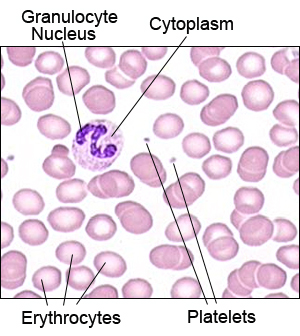Granulocyte - basophils, eosinophils, neutrophils

What are Granulocytes
Granulocyte - a type of LEUKOCYTE (white BLOOD cell) so named because its cytoplasm contains granules. The granules, called lysosomes in neutrophils, contain enzymes that digest proteins and carbohydrates, the basic components of cellular structures. Granulocytes are primarily phagocytic; their responsibility is to consume pathogens that lymphocytes and other leukocytes neutralize as part of the body’s IMMUNE RESPONSE. Pathologists refer to granulocytes as polymorphonuclear (PMN) because the nucleus of a granulocyte contains multiple lobes. Granulocytes have a short life span in the circulation, typically six to eight hours. After this time some of them migrate into the tissues and continue to function as phagocytes. The liver filters from circulation those that do not migrate and its phagocytic cells, the Kupffer cells, consume them. There are three types of granulocytes, named for the kinds of tissue dyes they accept to emphasize their structures for microscopic examination: basophils, eosinophils, and neutrophils.
Basophils
A basophil accepts a base dye such as methylene blue, accounting for its name, which means “base-loving.” Basophils respond to the various chemicals injured cells and pathogens release, among them HISTAMINE, serotonin, CYTOKINES, LEUKOTRIENES, and PROSTAGLANDINS. Basophils themselves also release these chemicals, which serves to further incite an inflammatory response as well as summon more leukocytes into action. Basophils filled with HISTAMINE granules are primarily responsible for HYPERSENSITIVITY REACTION and ALLERGY responses. They are abundant in the bronchial tissues during ASTHMA attacks, for example, and in the tissues surrounding an insect bite or sting.
Eosinophils
The eosinophil (“eosin-loving”) accepts a tissue dye called eosin for examination under the light microscope. Eosinophils, containing enzymes to digest bacteria and other pathogens, also have roles in histamine release (such as in hypersensitivity reactions and asthma) and inflammatory response. Parasitic infections, atopic DERMATITIS, non-Hodgkin’s LYMPHOMA, and OVARIAN CANCER are among the conditions that can cause elevated eosinophil levels. Medication reactions, notably with beta blockers and CORTICOSTEROID MEDICATIONS, are among the causes of lowered eosinophil levels. An eosinophil normally circulates about eight hours in the blood and then migrates into the tissues.
Neutrophils
The neutrophil (“neutral-loving”) stains neutrally for microscopic examination. It is the most abundant type of leukocyte in the blood, making up about 70 percent of the white blood cells in circulation. Neutrophils are the IMMUNE SYSTEM’s infantry, maintaining a strong defensive presence in the blood and swarming to attack invading pathogens. Neutrophils that die in the line of duty release toxic chemicals to continue their protective actions. Neutrophils are integral to the body’s inflammatory response and are often to blame for autoimmune attacks such as those that occur with RHEUMATOID ARTHRITIS and INFLAMMATORY BOWEL DISEASE (IBD). Numerous health conditions can lower the number of neutrophils in the blood circulation including infections, serious vitamin B deficiency, RADIATION THERAPY, CHEMOTHERAPY, and cancers such as LEUKEMIA and lymphoma. Some medications, notably antibiotics and NONSTEROIDAL ANTI-INFLAMMATORY DRUGS (NSAIDS), can also decrease the neutrophil level raising the risk for INFECTION.
For further discussion of granulocytes within the context of blood and lymph structure and function please see the overview section “The Blood and Lymph.”
See also CELL STRUCTURE AND FUNCTION; LYMPHOCYTE; MONOCYTE.